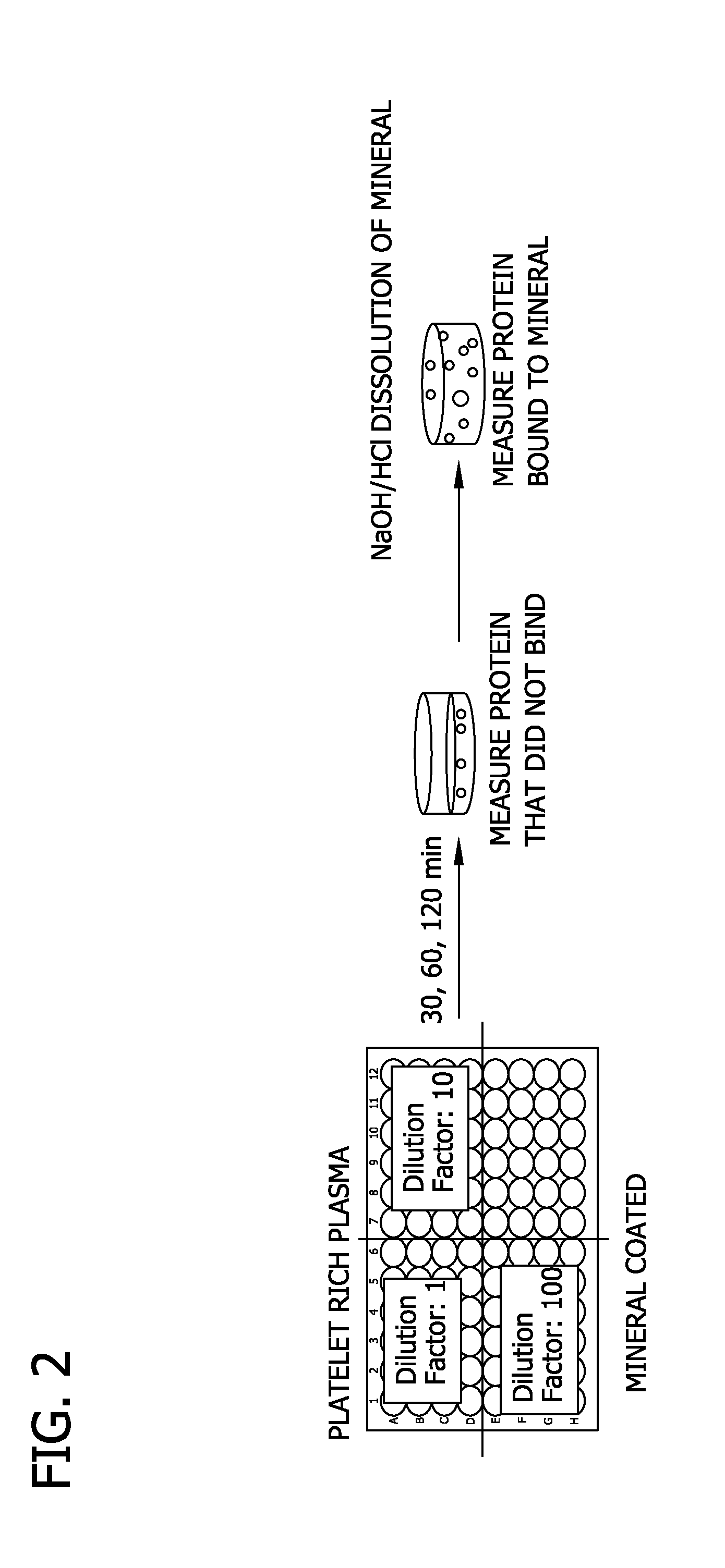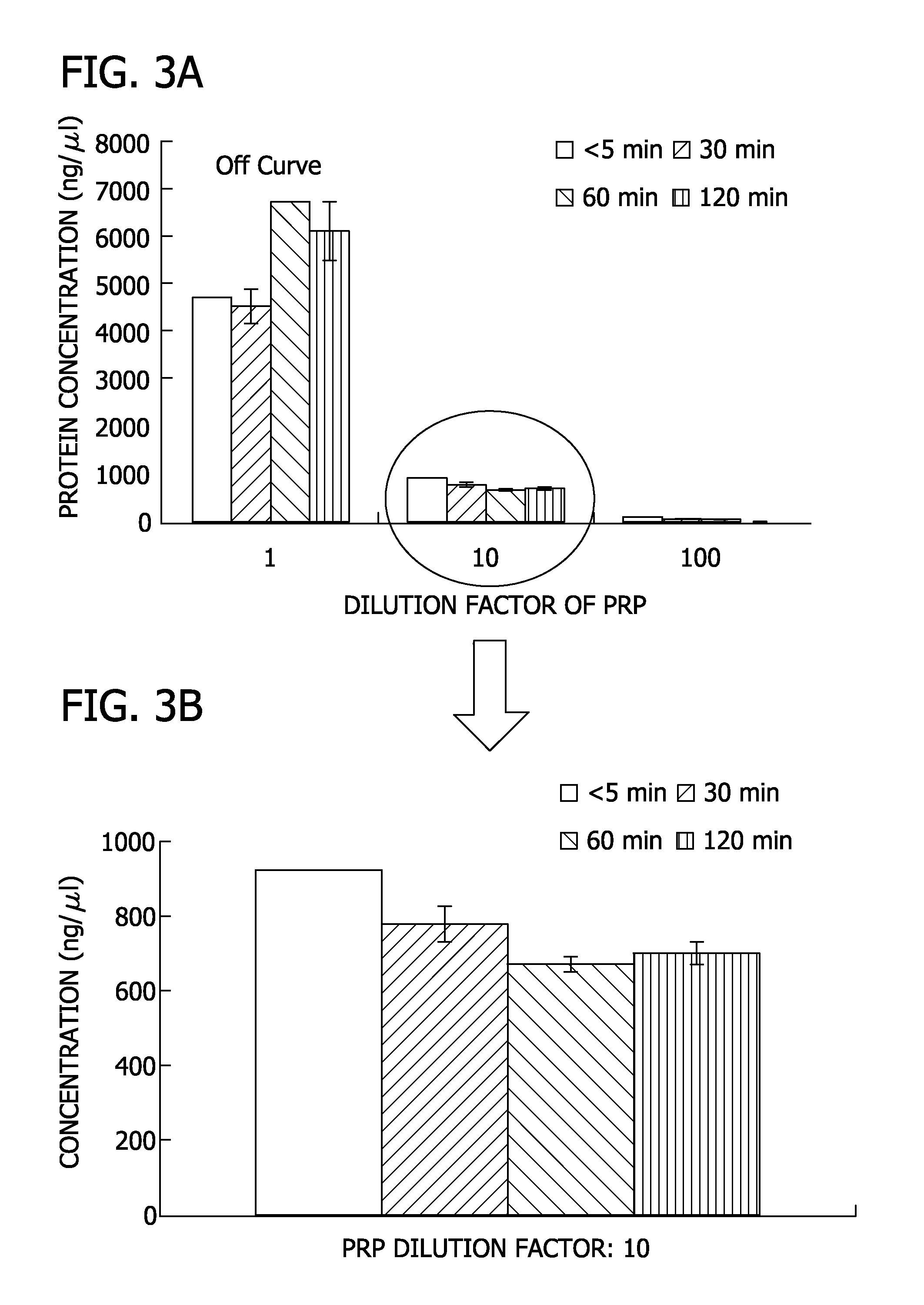Selection of platelet rich plasma components via mineral binding
a technology of platelet rich plasma and mineral binding, which is applied in the field of medical devices with mineral coated substrates and autologous biological molecules, can solve the problems of limited bioavailability, limited bioavailability, and the need to deliver large doses of biological molecules, and achieve the effect of reducing the number of patients
- Summary
- Abstract
- Description
- Claims
- Application Information
AI Technical Summary
Benefits of technology
Problems solved by technology
Method used
Image
Examples
example 1
Mineralized Film and PRP
[0079]In this Example, the protein concentration of PRP was determined after incubation with a mineralized poly lactide glycolide (PLG) film.
[0080]Specifically, poly lactide glycolide (85:15) was solvent casted into a film. The film was mineralized for 10 days using mSBF to form a mineralized coating on the PLG film (FIG. 1A and FIG. 1B). Blood was collected from sheep and centrifuged at 312×g and 1248×g to obtain PRP having a platelet count of 886 k / μl. PRP was subjected to cycles of freeze-thaw to lyse platelets. The resulting PRP was diluted by factors of 1, 10, and 100 in 0.001 M phosphate (PO4) buffer. The total protein concentration of each PRP dilution was determined by BCA assay.
[0081]As shown in FIG. 2, mineralized PLG films were incubated with each PRP dilution at 0 minute, 30 minute, 60 minute and 120 minute time points to allow proteins to bind to the mineralized PLG films. After incubation, the films were transferred to a new plate and rinsed wit...
example 2
Selective Elution of PRP Components
[0083]In this Example, elution of proteins from mineralized PLG wells with varying phosphate molarities was determined
[0084]Specifically, wells of a 96-well plate were coated with a mineralized film made as described above. PRP was obtained and subjected to cycles of freeze-thaw to lyse platelets as described above. As shown in FIG. 5, mineralized PLG wells were incubated for 1 hour to allow proteins to bind. Unbound proteins were rinsed off using water. Bound proteins were eluted from the mineralized PLG wells for 15 minute, 60 minute, and 90 minute time points using 0.001 M, 0.05 M, 0.11 M, 0.17 M, and 0.25 M PO4 (1st Protein Elution) and measured by BCA assay. Proteins that remained bound after the 1st Protein Elution were eluted from the mineralized PLG wells by incubating the mineralized PLG wells using 0.2 M NaOH. The 0.2 M NaOH eluate was neutralized using 0.2 M HCl in 0.01 M HEPES (2nd Protein Elution). The protein concentration of the 2nd ...
example 3
Selective Elution of PRP Components
[0088]In this Example, elution of proteins from mineralized PLG wells with varying phosphate molarities was determined
[0089]Specifically, PLG wells were mineralized as described above. PRP was obtained and subjected to cycles of freeze-thaw to lyse platelets as described above. As shown in FIG. 9, mineralized PLG wells were incubated for 1 hour to allow proteins to bind. Unbound proteins were rinsed off using water. Bound proteins were eluted from the mineralized PLG wells for less than 5 minutes (buffers were placed into the wells and immediately collected), 30 minutes and 90 minutes using water, 0.001 M, 0.05 M, 0.11 M, 0.17 M, and 0.25 M PO4 (1st Protein Elution; PO4 eluted) and measured using an AGILENT™ protein assay. Proteins that remained bound after the 1st Protein Elution (using phosphate buffer) were eluted a second time from the mineralized PLG wells by incubating the mineralized PLG wells using 0.2 M HCl / 0.01 M HEPES. The 0.2 M HCl / 0.01...
PUM
| Property | Measurement | Unit |
|---|---|---|
| pH | aaaaa | aaaaa |
| concentration | aaaaa | aaaaa |
| supraphysiological concentrations | aaaaa | aaaaa |
Abstract
Description
Claims
Application Information
 Login to View More
Login to View More - R&D
- Intellectual Property
- Life Sciences
- Materials
- Tech Scout
- Unparalleled Data Quality
- Higher Quality Content
- 60% Fewer Hallucinations
Browse by: Latest US Patents, China's latest patents, Technical Efficacy Thesaurus, Application Domain, Technology Topic, Popular Technical Reports.
© 2025 PatSnap. All rights reserved.Legal|Privacy policy|Modern Slavery Act Transparency Statement|Sitemap|About US| Contact US: help@patsnap.com



